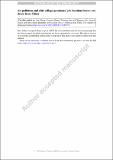Air pollution and elite college graduates’ job location choice: evidence from China
Author(s)
Zheng, Siqi; Zhang, Xiaonan; Sun, Weizeng; Lin, Chengtao
Download168_2019_939_ReferencePDF.pdf (865.6Kb)
Open Access Policy
Open Access Policy
Creative Commons Attribution-Noncommercial-Share Alike
Terms of use
Metadata
Show full item recordAbstract
In this paper, we examine the impact of air pollution on the job location choice of a highly educated labor force. Using the administrative job contract records of all graduates from Tsinghua University from 2005 to 2016, we find that air pollution significantly reduces the probability of elite graduates accepting job offers in a polluted city. Specifically, all else equal, if a city’s PM2.5 level increases by 10 μg/m3, the share of Tsinghua graduates choosing that city will decrease by 0.23 percentage point (9% of the mean value). This “crowding-out” effect is larger for master’s and doctoral graduates, but insignificant for undergraduates. A placebo test finds this effect does not exist for individuals who had signed a job contract prior to university admission, which strengthens our finding. Heterogeneity analysis indicates that males, students who grew up in cleaner provinces, and students graduating from school of the environment are more sensitive to air pollution. Different levels of preference for clean air and tolerance to pollution, as well as whether having the knowledge of pollution’s harms, can effectively explain the heterogeneous effect of air pollution’s impacts on job location choices of those elites.
Date issued
2019-08Department
Massachusetts Institute of Technology. Department of Urban Studies and Planning; Massachusetts Institute of Technology. Center for Real EstateJournal
Annals of Regional Science
Publisher
Springer Science and Business Media LLC
Citation
Zheng, Siqi et al. "Air pollution and elite college graduates’ job location choice: evidence from China." Annals of Regional Science 63, 2 (August 2019): 295–316 © 2019 Springer Nature
Version: Author's final manuscript
ISSN
0570-1864
1432-0592